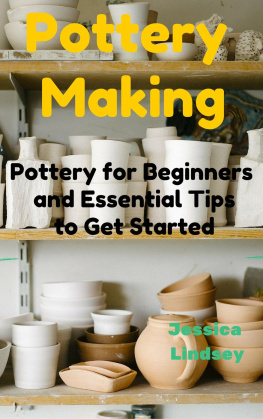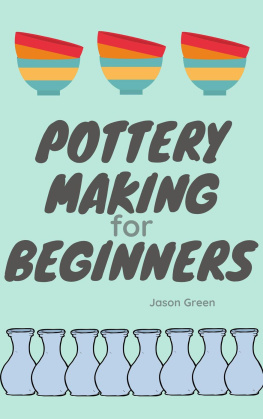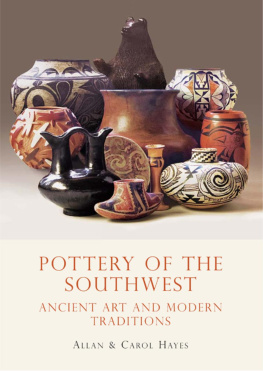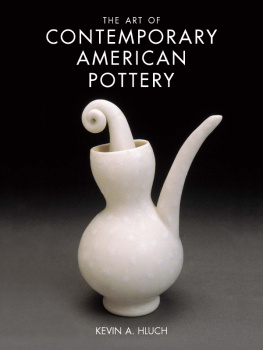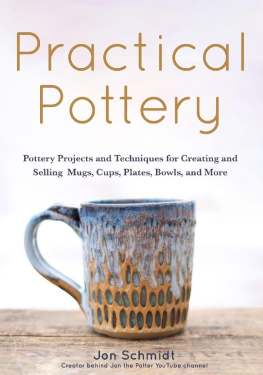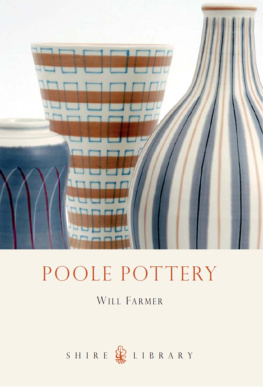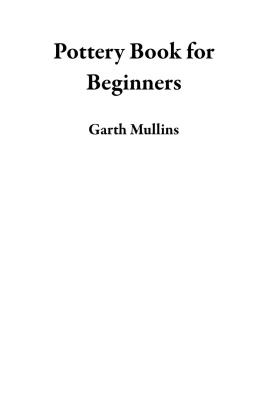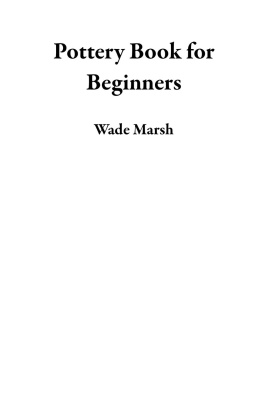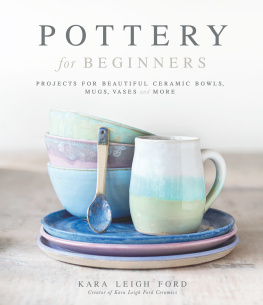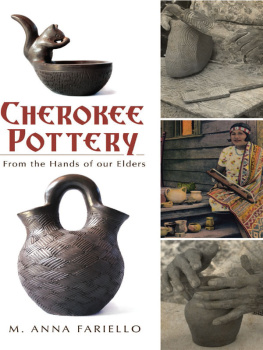Pottery Making: Pottery for Beginners and Essential Tips to Get Started
by Jessica Lindsey
All Rights Reserved. No part of this publication may be reproduced in any form or by any means, including scanning, photocopying, or otherwise without prior written permission of the copyright holder. Copyright 2015
Table of Contents
1. Some pottery tips for beginners
P ottery is creative art and most people will get into it as a matter of hobby. However, some of those who have gone into pottery as a hobby have actually ended up becoming professional potters. Once the individual interested in pottery starts producing beautiful vases and mugs for their loved ones, the vibes just spread and before they know, they are producing for the whole neighborhood.
For most beginners, venturing into pottery is not always and easy task and tips from expert potters are always welcomed in this guide we have taken a brief look on how to decide if it is time to set up a studio and some of the problems that you may come across as you continue in your goal to become a better potter.
2. Set up a pottery studio
I f you are really that interested in pottery, then you may want to consider certain things when it comes to setting up a studio.
How interested are you in pottery? Are you just doing it for fun or are you looking to get into it as a business? The answers to these questions will help you determine the amount of space that you will need for the studio. If you are just doing it for fun then you will survive working from your back yard. If however, you are doing it as a business and hope to grow it big, then you should consider getting a studio away from home.
Are you going to be building pots through hand building or by throwing? Those who build by hand can manage to do so from a space that is small most probably from their house.
When considering setting up a studio, it is wise to consider storage space for working tools and materials as well as for the pots that will be created.
Consider your plumbing needs. Pottery requires a lot of work with water. However, it is important to think of how you will get rid of any waste waters from the process as clay water should not be dumped down the plumbing system. They will easily clog the system.
3. How to select a pottery tool
E ver since the Chinese formed their terracotta army that is said to have been made more than thirty millennia ago the tools used in pottery have remained mostly the same although slightly modified from one generation to another. Today pottery tools include those used for preparing the clay and those used modeling the clay. Tools used for preparation include wheels on which the potter does most of the work. They also include moulds that are forms in which pottery is formed. Modeling tools like clay guns are used to shape clay. There are other tools whose role is to clean up the shape once it is formed.
Tools used for preparing clay include different types of wheels which range from pottery wheels turntables and pottery mould. Turntables are used to automatically turn the pottery while the potter is at work. Pottery wheels can be manual or electric, electric wheels and manual wheels. The main point when choosing electric wheels is to consider horsepower. Manual wheels can be powered by a kick wheel or a foot treadle. Pottery moulds are used to produce simple to complex types of pottery based on the type of mould.
Tools used for modeling are many and a few will be discussed hear. Wooden or stainless steel pottery tools are used for hand building operations. Pottery calipers are use to measure the dimensions where different parts of a pot meet. Pottery hole cutters are used to cut different size holes in pottery. Clay spatulas are used in smoothing pottery work. Pottery rib tools that can be made of rubber or wood are used to shape pots while they are still on the wheel.
4. How to Select a Perfect Electric Pottery Wheel
G enerally the key to getting the right wheel is to know what you will be using it for. For example, a 1 horse power wheel will be useless if you are only interested in making small vases. The guide to buying the right electric pottery wheel is the power, the quality, the features, its portability, and also the price.
Power is fairly easy to sort out. Most wheels will range from between a quarter to one and a half horse power. While buying you can ask the manufacturer on advice of how much clay you will be able to center on a particular wheel. Those who are looking to make small toy pottery will be satisfied with a wheel of a quarter horse power. The majority of potters will be happy to work with a wheel of half horse power. Those who will be working on taller vases will have to work with wheels that have a horse power between one and one and a half horse power.
Quality is important as it will help you decide on the right wheel to buy. Some wheels may be too noisy while others will turn at different speeds. The smoothness of the wheel is very important for those working with porcelain. Those who are working mostly at night may want to reconsider buying noisy wheels.
Features that come with a wheel may vary depending on the person who is going to use the wheel. Most potters wouldnt want water splashing everywhere so they will prefer a wheel with splash guard. Those who love throwing standing up may choose to get a leg extension kit to attach the wheel to. It will also be important to determine the right wheel size and if removable bats can be attached to it.
Portability is another factor to consider when choosing a wheel. Will you be moving your wheel all over the place or is your wheel going to remain on one spot for decade. If you are going to be moving your wheel, then you need a wheel that is light and easily. If the machine is going to stay in place for long periods, then a heavy machine will be better.
5. How to choose and buy the best clay
O ne of the things that will determine success in a pottery studio is the type of clay that you use. Arguably, the quality of pottery you produce will depend more on the time and effort put into forming the pottery. The clay may come only second to this. However, this does not mean the clay is not important. The clay you buy will depend on the product you are trying to produce and the color and temperature that you are expecting to use with the clay. When you go out to buy, you will come across earthenware, porcelain or ceramic. The one you buy will depend on you understanding the properties of the particular clay.
When working with clay, there may be different things you lookout for. Some people may look for clay with little moisture, others will be looking for clay that does not shrink as much and others will be bothered. Except for the color that can be chosen as it is, it may be necessary to test the clay. This may require firing up at different temperatures and checking how it holds up.
6. How to work through the wobble
O nce you start working with clay, you will find that sometimes the pottery will just wobble and come out awkward. This can be a challenging situation for a beginner who needs all the help they can get to stay focused and interested. If you find yourself with a wobbly product, there a couple of things that may be causing it. The clay may not be centered. The potter may not be compressing the clay evenly or the clay that was used was too thin.
The first thing to do when you notice the clay work is wobbly is to try and center it. The first step to making sure that the clay to properly center your body over the wheel and stay firmly grounded. When it comes to ensuring that the clay is not wobbly, the hands are the best tools. Wet hands and place them on both side of the clay, gently but firmly pull and push your palms across the clay making sure it is evenly compressed from both sides. Alternatively, you can place one hand on the side of the clay and the other at the top.
Next page
